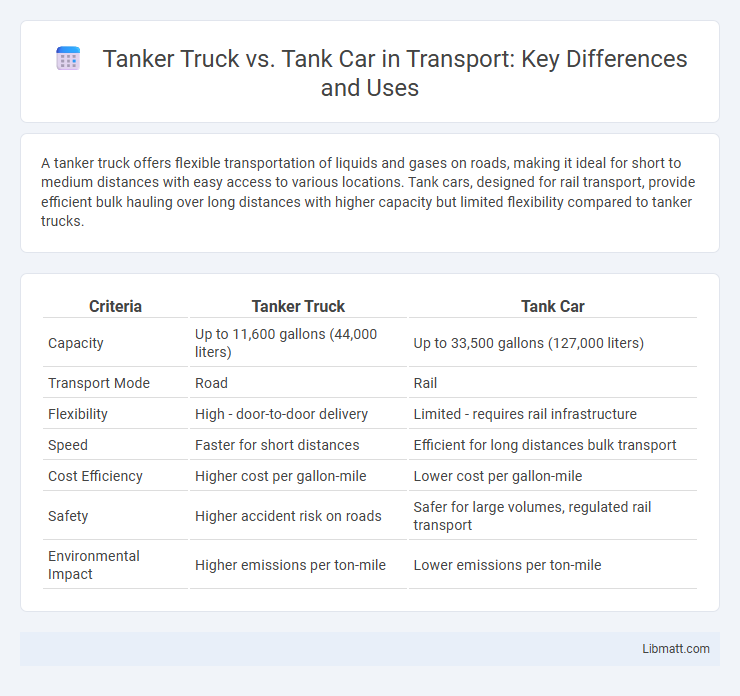A tanker truck offers flexible transportation of liquids and gases on roads, making it ideal for short to medium distances with easy access to various locations. Tank cars, designed for rail transport, provide efficient bulk hauling over long distances with higher capacity but limited flexibility compared to tanker trucks.
Table of Comparison
| Criteria | Tanker Truck | Tank Car |
|---|---|---|
| Capacity | Up to 11,600 gallons (44,000 liters) | Up to 33,500 gallons (127,000 liters) |
| Transport Mode | Road | Rail |
| Flexibility | High - door-to-door delivery | Limited - requires rail infrastructure |
| Speed | Faster for short distances | Efficient for long distances bulk transport |
| Cost Efficiency | Higher cost per gallon-mile | Lower cost per gallon-mile |
| Safety | Higher accident risk on roads | Safer for large volumes, regulated rail transport |
| Environmental Impact | Higher emissions per ton-mile | Lower emissions per ton-mile |
Introduction to Tanker Trucks and Tank Cars
Tanker trucks are specialized road vehicles designed to transport liquid or gas commodities, featuring cylindrical tanks mounted on truck chassis for flexibility and access to various locations. Tank cars are railroad freight cars specifically constructed to carry bulk liquids or gases, utilizing robust steel tanks to safely transport large volumes over long distances via rail networks. Both tanker trucks and tank cars serve critical roles in the logistics and distribution of hazardous and non-hazardous materials, with differences in capacity, speed, and routing based on transport mode.
Key Differences Between Tanker Trucks and Tank Cars
Tanker trucks and tank cars differ primarily in transportation mode and capacity, with tanker trucks designed for road transport and typically carrying smaller loads ranging from 5,000 to 11,600 gallons, while tank cars operate on railroads and can hold between 20,000 to 34,000 gallons. Tanker trucks offer greater flexibility for door-to-door delivery and access to remote locations, whereas tank cars provide cost-efficiency for large-volume bulk shipments over long distances. Your choice depends on factors like cargo type, shipment size, distance, and destination accessibility, making it essential to weigh these variables in logistics planning.
Design and Construction Features
Tanker trucks feature a cylindrical, pressurized or non-pressurized steel or aluminum tank mounted on a heavy-duty chassis, optimized for road transport with multiple compartments for varied cargo. Tank cars, designed for rail transport, have a robust steel tank welded to a heavy steel frame, equipped with safety valves and pressure relief devices to withstand high-impact conditions during transit. Both designs prioritize containment integrity, corrosion resistance, and ease of loading and unloading, but tank cars often handle larger volumes with reinforced structures for rail-specific stresses.
Capacity and Volume Comparison
Tanker trucks typically have capacities ranging from 5,000 to 11,600 gallons, making them ideal for smaller, flexible deliveries over shorter distances. Tank cars, on the other hand, can carry significantly larger volumes, often between 20,000 to 34,000 gallons, optimized for bulk transportation via rail. Your choice between these two depends on required volume and delivery logistics, with tank cars suited for high-volume, long-distance shipments.
Typical Uses and Cargo Types
Tanker trucks primarily transport liquid commodities such as gasoline, chemicals, and food-grade liquids over short to medium distances, offering flexibility and door-to-door delivery. Tank cars, used in rail transport, handle large volumes of bulk liquids including crude oil, liquefied gases, and industrial chemicals, ideal for long-haul shipments across regions. Both tanker trucks and tank cars ensure safe containment of hazardous and non-hazardous liquids, but tank cars support higher capacity loads suited for large supply chain demands.
Safety Considerations and Regulations
Tanker trucks and tank cars operate under stringent safety regulations tailored to their transportation modes, with the Pipeline and Hazardous Materials Safety Administration (PHMSA) enforcing specific federal guidelines for both. Tanker trucks face increased risks due to road hazards and require compliance with Federal Motor Carrier Safety Administration (FMCSA) standards, including crashworthiness and spill prevention measures. Tank cars adhere to Federal Railroad Administration (FRA) protocols, focusing on enhanced tank design and derailment resistance to minimize hazardous material release during rail transport.
Loading and Unloading Procedures
Tanker trucks use flexible hoses and pumps for rapid loading and unloading, suitable for various liquids including hazardous materials, with emphasis on safety protocols and spill containment. Tank cars rely on gravity or pneumatic systems for loading and unloading, typically at fixed rail terminals designed for bulk transport efficiency. Your choice depends on logistical needs, as tanker trucks offer door-to-door service while tank cars excel in transporting large volumes over long distances.
Efficiency and Transportation Logistics
Tanker trucks offer flexible routing and door-to-door delivery, making them ideal for short to medium distances and varied locations, while tank cars provide superior fuel efficiency and capacity for transporting large volumes over long distances via rail networks. Tank cars reduce congestion on highways and enable bulk transportation, significantly lowering per-unit costs in large-scale logistics operations. Combining both modes in intermodal shipping can optimize supply chain efficiency by balancing delivery speed and cost-effectiveness.
Environmental Impact and Sustainability
Tanker trucks generally have higher carbon emissions per ton-mile compared to tank cars due to lower fuel efficiency and smaller cargo capacity, contributing to a larger environmental footprint. Tank cars, operated on railroads, benefit from economies of scale and produce fewer greenhouse gases, making them a more sustainable option for transporting bulk liquids over long distances. The shift toward rail transport for hazardous materials supports better environmental outcomes by reducing road congestion and minimizing spill risks associated with tanker truck accidents.
Choosing the Right Option for Your Needs
Selecting between a tanker truck and a tank car depends on factors like cargo type, route flexibility, and volume requirements. Tanker trucks offer greater maneuverability for short-distance or last-mile delivery, while tank cars provide cost-effective bulk transport over long distances on rail networks. Evaluating shipment size, delivery timelines, and infrastructure accessibility ensures the optimal choice for efficient and safe liquid or gas transportation.
tanker truck vs tank car Infographic

 libmatt.com
libmatt.com